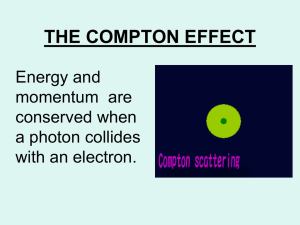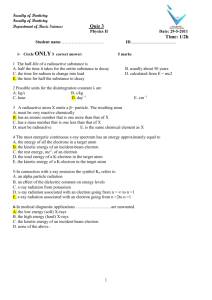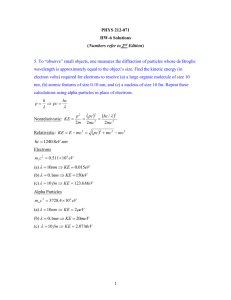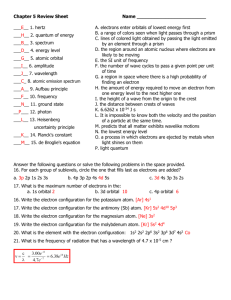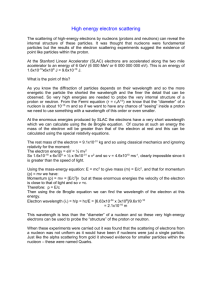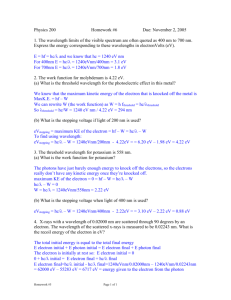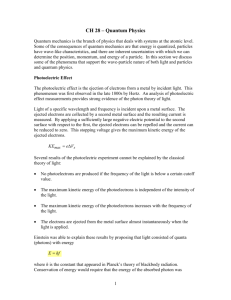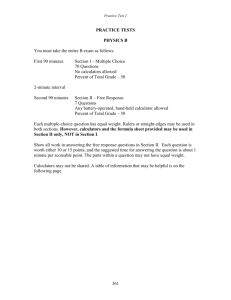Answers to multiple choice: c,c,b,b,d,a,c,d,b,c,c,b,b,b,e
advertisement
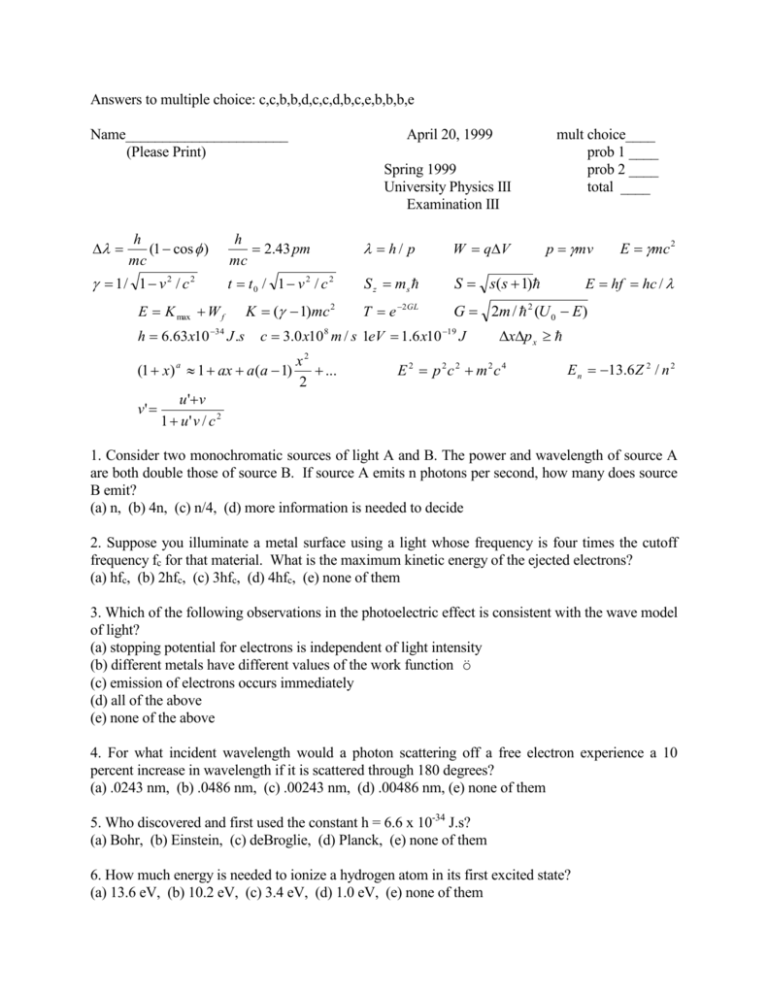
Answers to multiple choice: c,c,b,b,d,c,c,d,b,c,e,b,b,b,e Name______________________ (Please Print) April 20, 1999 Spring 1999 University Physics III Examination III h (1 cos ) mc 1/ 1 v 2 / c 2 h 2.43 pm mc h/ p W q V t t0 / 1 v 2 / c 2 S z ms S s(s 1) K ( 1)mc 2 T e 2GL G 2m / 2 (U 0 E ) E K max W f h 6.63 x10 34 J .s c 3.0 x10 8 m / s 1eV 1.6 x10 19 J (1 x) a 1 ax a(a 1) v' u 'v 1 u' v / c 2 mult choice____ prob 1 ____ prob 2 ____ total ____ 2 x ... 2 p mv E mc 2 E hf hc / xp x E 2 p 2c 2 m2c 4 E n 13.6 Z 2 / n 2 1. Consider two monochromatic sources of light A and B. The power and wavelength of source A are both double those of source B. If source A emits n photons per second, how many does source B emit? (a) n, (b) 4n, (c) n/4, (d) more information is needed to decide 2. Suppose you illuminate a metal surface using a light whose frequency is four times the cutoff frequency fc for that material. What is the maximum kinetic energy of the ejected electrons? (a) hfc, (b) 2hfc, (c) 3hfc, (d) 4hfc, (e) none of them 3. Which of the following observations in the photoelectric effect is consistent with the wave model of light? (a) stopping potential for electrons is independent of light intensity (b) different metals have different values of the work function ö (c) emission of electrons occurs immediately (d) all of the above (e) none of the above 4. For what incident wavelength would a photon scattering off a free electron experience a 10 percent increase in wavelength if it is scattered through 180 degrees? (a) .0243 nm, (b) .0486 nm, (c) .00243 nm, (d) .00486 nm, (e) none of them 5. Who discovered and first used the constant h = 6.6 x 10-34 J.s? (a) Bohr, (b) Einstein, (c) deBroglie, (d) Planck, (e) none of them 6. How much energy is needed to ionize a hydrogen atom in its first excited state? (a) 13.6 eV, (b) 10.2 eV, (c) 3.4 eV, (d) 1.0 eV, (e) none of them 7. Suppose photon A undergoes Compton Scattering off a free electron and scatters through 90 degrees, and photon B scatters off a free proton and scatters directly backwards. What is the ratio of the change in wavelength of A and B, assuming protons are 1836 times as massive as electrons? (a) 1836 times greater for A than B, (b) 1836 times greater for B than A (c) 918 times greater for A than B, (d) 918 times greater for B than A 8. Bohr's postulate that stable orbits have quantized angular momentum can be derived using what equation(s)? (a) h / p , (b) ke2/r2 = mv2/r, (c) n 2r , (d) both a and c, (e) both a and b 9. An electron is confined to a box of width L. Its possible states may be described by an infinite number of possible wave functions: øn, n = 1,2,3,... For which n value(s) would the electron never be found in the middle of the box? (a) all n values, (b) all even n, (c) all odd n, (d) all n > 1, (e) none of them 10. Suppose an electron of mass m confined to a box of width L absorbs a photon of energy E = 5h2/8mL2. In what state was the energy of the electron before and after it absorbed the photon? (Hint: How is the photon energy related to the energy of the electron before and after emission?) (a) n=1 before, n=2 after, (b) n=1 before, n=3 after, (c) n=2 before, n=3 after, (d) n=2 before, n=4 after (e) none of the above 11. An electron tunnels through a barrier with a probability 10-4. What is the transmission probability through the same barrier for a particle of the same energy, but having 100 times the mass of the electron? (a) 10-2, (b) 10-3, (c) 10-5, (d) 10-6, (e) none of them 12. Which of the following is an example of the Uncertainty Principle? (a) my inability to answer this question (b) the increase in electron diffraction occurring when a slit is narrowed (c) the inherent imprecision in making any measurement (d) the spread in photon momentum found when using a white light source (e) none of the above 13. What is the deBroglie wavelength of a 0.1 kg baseball travelling at 10 m/s? (a) 0.1h, (b) h, (c) 10h, (d) 100h, (e) none of the above 14. Suppose an electron of mass m is known to lie within a region of width L. What is the minimum uncertainty in its speed? (a) 0, (b) / mL , (c) mL , (d) m / L , (e) none of them 15. Two electrons of rest mass m collide head on with equal and opposite momenta, and they produce four new particles each having the rest mass of an electron -- for a total of six particles. What were the smallest possible momenta of the electrons before they collided? (a) 2.24 mc, (b) 3.67 mc, (c) 4.19 mc, (d) 7.41 mc, (e) none of them 1. 10pts (a)A rocket ship heads toward a star 10 light years from Earth (according to Earth observers.) How long will the trip last according to the rocket observer's time, if the ship travels at 80 percent the speed of light? The speed of light c = 1 light-year per year, so to travel 10 light-years at v = 0.8 c takes a time t = x/v = 10 ly/0.8 ly/yr = 12.5 yrs Earth time, and t 0 t 1 v 2 / c 2 7.5 yrs ship time 10pts (b)Up to what speed is the non-relativistic formula for kinetic energy in error by no more than one part in a billion. K ( 1)mc 2 mc 2 (1 v 2 / 2c 2 3v 4 / 8c 2 ... 1) K non rel 1 / 2mv 2 K 3 / 8(mv 4 / c 2 ) 10 9 (1 / 2mv 2 ) giving v (3.5 x10 5 )c 10pts (c)Two rocket ships approach each other, each having a speed v according to an observer on Earth. Find v, if an observer on one of the two ships sees the other approach at a speed 1.5v. v' vu 1 uv / c 2 1.5(1 v 2 / c 2 ) 2 Use: v=u and v’=1.5 v to get: 1.5v or: vv 1 v2 / c2 giving v c/ 3 2. 10pts (a)Explain how we know experimentally that material particles like electrons have a wave nature. Why is it not possible to demonstrate the wave nature of baseballs? Because when particles like electron are sent through a crystal which acts like a diffraction grating, we see interference maxima appearing at just the angles predicted by their deBroglie wavelength. Given deBroglie’s formula, the wavelength depends inversely on an object’s mass, so objjects like baseballs would have far too small a wavelength to ever notice. 10pts (b)Consider a Compton scattering experiment in which photons are observed after a scattering by 900. What must be the energy of the incident (original) photons if the scattered photons have an energy of 20 keV? h / mc(1 cos ) 2.43x10 12 m ' hc / E (6.63x10 34 )(3.0 x108 ) /( 20 x10 3 )(1.6 x10 19 ) 6.21x10 11 m ' 6.21x10 11 0.243x10 11 5.97 x10 11 m E ' hc / ' (6.63x10 34 )(3.0 x108 ) /(5.97 x10 11 )(1.6 x10 19 ) 20.8x10 3 eV 20.8keV 10pts (c)What are the two longest wavelengths that could be absorbed by a He+ ion in its ground state? The energy levels are given by: E n 13.6 Z 2 / n 2 with Z=2 here The 2 longest wavelengths involve the following two transitions: n= 12 and 13, and are hc /( E2 E1 ) (hc / 13.6 x2 2 (1.6 x10 19 ))(12 1 / 2 2 ) 30.5x10 9 m 30.5nm hc /( E3 E1 ) (hc / 13.6 x 2 2 (1.6 x10 19 ))(12 1 / 3 2 ) 45.7 x10 9 m 45.7nm



